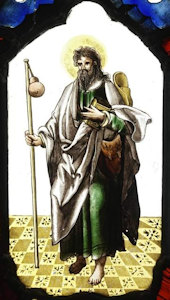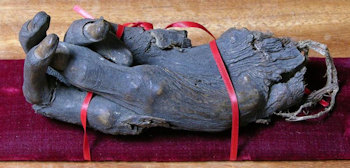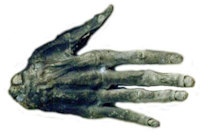St. James the Greater
 |
St. James The Greater, stained glass panel, 1618. Museum no. C.235-1934, Guthrie bequest. V&A Museum London |
Saint James the Greater is one of the Twelve Apostles of Jesus Christ. He is called 'the Greater' to distinguish him from 'James the Less', another Apostle. He worked as a fisherman with his brother, John, his father, Zebedee, and his partner, Simon. Following the crucifixion of Jesus Christ, James made a pilgrimage to the Iberian Peninsula to spread the word of Jesus. When he returned to Judea, he was beheaded by King Herod Agrippa I in the year 44AD and the first apostle to be martyred. The remains, or relics, of St James the Greater, were then transported by his followers to the Iberian Peninsula (today’s Galicia in Spain) and are said to be buried in Santiago de Compostela, which is why St James the Greater is now the patron saint of Spain.
In the New Testament in the bible the book of St. James has a passage which links him to healing James 5: 13-15 “Is anyone among you suffering? He should pray. Is anyone happy? He should sing songs of thanks to God. Is anyone among you sick? He should send for the church leaders and they should pray for him. They should pour oil on him in the name of the Lord. The prayer given in faith will heal the sick man, and the Lord will raise him up. If he has sinned, he will be forgiven.” Many pilgrims make the pilgrimage to Santiago de Compostela in North Western Spain to the burial place of St. James to cure their ills.
In the medieval period the story of St James was greatly embellished. In northern Spain a legend developed that he had travelled to the coast of Galicia in order to convert the local population. After he was martyred in Jerusalem, his servant brought his body back to Galicia by sea. As the boat approached the shore, a startled horse threw its rider to the ground, and the man drowned. The servant prayed, and miraculously the man emerged alive from the water, covered in cockleshells, hence James's shell. In the early 9th century the bishop of the area claimed that God had told him where to find the body of St James. He built a church on the site. By the 11th century Santiago de Compostela was a major pilgrimage destination; it still attracts thousands every year. Saints were often thought of as protectors, and the possession of relics of an important one was to be ensured of divine protection.
Warter Church's dedication is to Saint James and an inventory was taken prior to the supression of the priory in 1536. Its site and possessions were granted to Thomas Manners, Earl of Rutland, a descendant of the founder, together with the priory church, its bell towers, bells, lead, and cemetery. The clear annual value of Warter Priory was given as £144 7s. 8d. Amongst the items listed was the principle relic of 'Saynt Jamys hand.' and in the inventory weighed 27½ ounces. This is surprising as the known Catholic relic of the hand of Saint James resided in Reading Abbey for Centuries and is well documented. It still survives today and is preserved in St Peter's RC Church, Marlow. It was given by Henry I’s daughter the Empress Matilda, in 1133. Matilda inherited it on the death of her husband, the Emperor Henry V, and it ultimately came from an arm taken from the grave of the apostle by the Bishop of Altino in the 4th century.
A date coincidence is that Warter Priory was founded in 1132 one year prior to this event by Geoffrey Fitz Pain (son of William Trusbut). William Trossebot or Trusbut was one of the new men, raised by Henry I from comparative obscurity.
 This relic is said to have possessed powerful healing properties, performing miracle cures throughout the twelfth century. Reading Abbey sold 'Water of St. James' to pilgrims - presumably that in which the hand had been dunked. It was still at Reading abbey when Thomas Cromwell’s commissioner made a visitation on the eve of the Dissolution, after which it disappeared from sight. Then, in October 1786, workmen digging the foundations for the new Reading Gaol discovered a left hand hidden in a wall at the east end of the abbey church. By 1897 this hand had found its way to the Roman Catholic Church in Marlow, Bucks, where it remains to this day. This relic is said to have possessed powerful healing properties, performing miracle cures throughout the twelfth century. Reading Abbey sold 'Water of St. James' to pilgrims - presumably that in which the hand had been dunked. It was still at Reading abbey when Thomas Cromwell’s commissioner made a visitation on the eve of the Dissolution, after which it disappeared from sight. Then, in October 1786, workmen digging the foundations for the new Reading Gaol discovered a left hand hidden in a wall at the east end of the abbey church. By 1897 this hand had found its way to the Roman Catholic Church in Marlow, Bucks, where it remains to this day.
But why would Warter Priory also possess a hand of Saint James?
The answer may lie not only in the dedication of the Church to James the greater, but also from 1277 when Warter Priory took possession of St. Giles Hospital in Beverley. Together with its church and churchyard it evidently stood on the west side of Lairgate in Beverley, to the north of Minster Moorgate. Warter Priory was dissolved in 1536 and the Beverley site was granted to Thomas Manners, Earl of Rutland, the same year. The site evidently subsequently belonged to Robert Grey (d. 1557) and, the 'manor' of St. Giles, was then acquired by Ralph Hansby in 1582.
The miracles associated with the hand of Saint James are documented in an article written by the late Brian Kemp in the Berkshire Archaeological Journal No. 65. 1970 In all Brian lists 27 miracles associated with the hand, all but two of which were miraculous cures. It is not known why Warter Priory would also possess a hand of Saint James, as the Reading Abbey hand is obviously well documented. The Catholic Church made myths, mystery, relics and pilgrimages into revenue generation and there is no doubt that Warter Priory would have benefited from this story of the hand of Saint James and it's healing properties. It would have been very useful for the priory to be able to attract pilgrims to St. Giles Hospital in Beverley and any revenue from the healing would be beneficial for the running of Warter Priory.
Interestingly, the hand that was in Reading Abbey for many years and now in Marlow Church was subject to radio carbon investigation in 2018 (see reference below) and the result was: "The hand was recently submitted to the Oxford University Research Laboratory for Archaeology and the History of Art for radiocarbon dating, and the results were made available to St Peter’s in Marlow earlier this year. Radiocarbon dating provides a value for the date of death of a living organism, calculated from the decay of radioactive carbon-14 in a sample. If this were the hand of St James the Great, we would expect a date range around the year 44 AD when he was executed. The results date the death of the hand to AD 994 – 1037 with a 68% degree of certainty, and to AD 987 – 1150 with a 95% degree of certainty."
So, where is the Warter Priory hand now?
 It probably has disappeared over time, but by coincidence another mummified hand turned up in Yorkshire and is known as the Hand of Glory. The mummified severed human hand is now stored in Whitby Museum. It was discovered by a stonemason and local historian, Joseph Ford in the early twentieth century hidden on the wall of a thatched cottage in Castleton. He immediately identified it from popular stories of such objects, as a “Hand of Glory”. It was given to Whitby Museum in 1935 and is the only alleged hand known to survive. It certainly would be interesting to also have a radio carbon date on the Whitby Museum hand and also to see if it weighed 27½ ounces! It probably has disappeared over time, but by coincidence another mummified hand turned up in Yorkshire and is known as the Hand of Glory. The mummified severed human hand is now stored in Whitby Museum. It was discovered by a stonemason and local historian, Joseph Ford in the early twentieth century hidden on the wall of a thatched cottage in Castleton. He immediately identified it from popular stories of such objects, as a “Hand of Glory”. It was given to Whitby Museum in 1935 and is the only alleged hand known to survive. It certainly would be interesting to also have a radio carbon date on the Whitby Museum hand and also to see if it weighed 27½ ounces!
Andrew Sefton
April 2020
References:
https://pocklingtonhistory.com/district/warter/excavations/index.php
https://www.british-history.ac.uk/vch/yorks/east/vol6/pp180-183#h3-0006
Berkshire Archaeological Journal No. 65. 1970
http://etheses.whiterose.ac.uk/4268/1/DX089185.pdf
https://medieval-sculpture.com/2018/10/19/not-the-hand/
|

